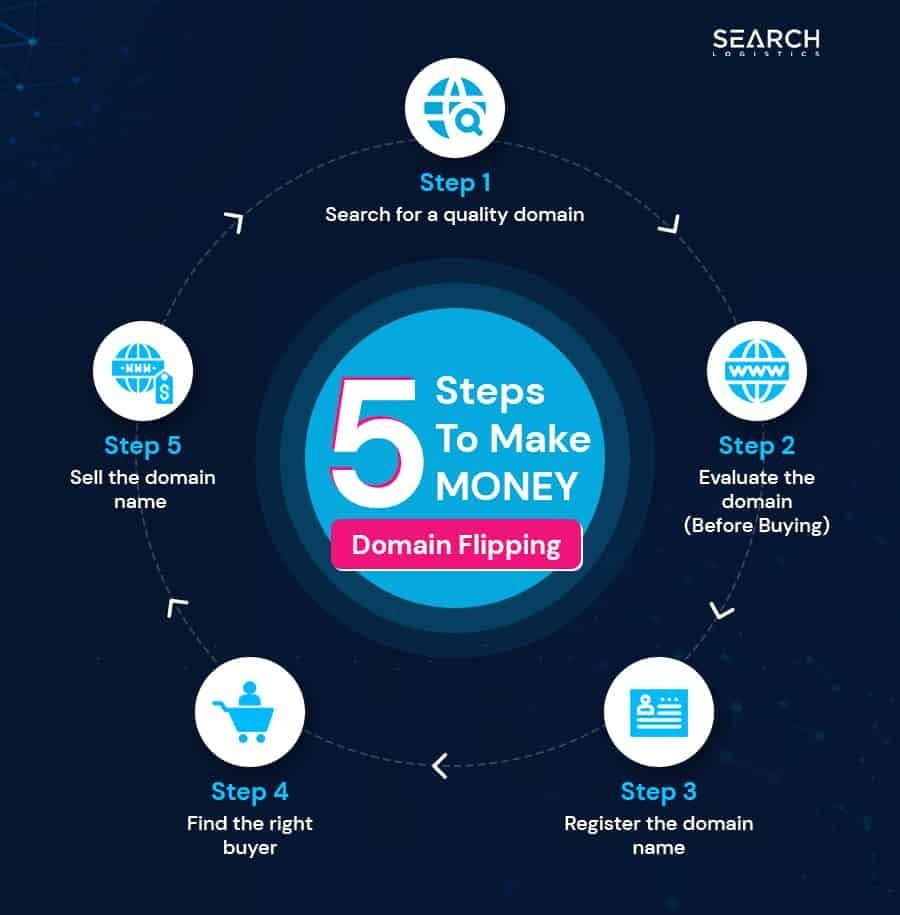Table of Contents
- Understanding Domain Flipping as a Profitable Venture
- Identifying Lucrative Domain Names in Todays Market
- Strategies for Successfully Buying and Selling Domains
- Navigating the Legal Landscape of Domain Flipping
- Maximizing Your Profits: Tips for Effective Marketing and Sales
- Q&A
- To Wrap It Up


Understanding Domain Flipping as a Profitable Venture
In the digital landscape, the art of acquiring and reselling domain names has gained significant traction as a lucrative pursuit. Many entrepreneurs are tapping into this market by identifying valuable domain names that have a high potential for resale. The success of domain flipping hinges on a few key factors, including keyword relevance, length and memorability, and extensibility. Domains that are short, catchy, and rich in relevant keywords often attract higher bids, making them appealing to prospective buyers.
To navigate the domain flipping space effectively, it’s essential to understand market trends and consumer behavior. Keeping an eye on emerging industries and popular niches can give you an edge when selecting domains to acquire. Here are a few tips to consider:
- Focus on trending industries: Domains relating to tech, health, and e-commerce often attract more interest.
- Seek out premium extensions: While .com domains are traditional favorites, new extensions like .io or .ai often resonate well in specific markets.
- Utilize domain appraisal tools: Tools such as Estibot can help assess the value of a domain based on metrics like search volume and traffic.
Once you have a selection of promising domains, the next step is to optimize your selling strategy. Marketing your domains effectively can greatly enhance their perceived value, leading to quicker sales and higher profits. Consider the following strategies:
| Strategy | Description |
|---|---|
| Email Outreach | Contact potential buyers through personalized emails to showcase the relevance of your domain. |
| Listing on Marketplaces | Utilize platforms like Sedo or Flippa to list your domains for higher visibility. |
| SEO Optimization | Use relevant keywords in your listings to attract search traffic interested in buying domain names. |


Identifying Lucrative Domain Names in Todays Market
When venturing into the world of domain flipping, identifying quality domains is crucial. Start by focusing on keywords that are trending and align with current market demands. Utilizing tools like Google Trends or keyword planners can help pinpoint popular search terms that potential buyers might be interested in. Look for domains that are not only catchy but also relevant to industries that are experiencing growth, such as technology, health, or e-commerce.
Next, consider the length and memorability of the domain name. Short, simple domains tend to be more appealing and easier for users to remember. A few characteristics to keep in mind include:
- Clarity: Ensure the name conveys a clear idea of its purpose.
- Spelling: Avoid complicated spellings that could confuse potential visitors.
- Brandability: Think about how the name could be used as a brand in the future.
Lastly, don’t overlook the importance of existing traffic and backlinks. A domain that already has some organic traffic or established backlinks can be immensely valuable. Use tools such as Ahrefs or SEMrush to analyze a domain’s traffic statistics and backlink profile. Here’s a simple table to illustrate the factors worth considering when evaluating a domain:
| Factor | Importance (1-5) | Notes |
|---|---|---|
| Keyword Relevance | 5 | Directly tied to popularity and search volume. |
| Length | 4 | Shorter is typically better for memorability. |
| Traffic | 5 | Establishes domain value and potential. |
| Backlinks | 4 | Enhances credibility and SEO potential. |
Strategies for Successfully Buying and Selling Domains
Engaging in domain flipping requires a combination of market awareness and strategic planning. First, it’s essential to identify trending keywords and industries that are likely to see growth. This foresight enables you to purchase domains that are not only relevant now but will likely increase in value over time. Tools like Google Trends, SEMrush, and Ahrefs can assist with keyword research and analysis to spot trends in potential domains.
Once you have acquired the domains, the next step is effectively marketing them to potential buyers. Listing your domains on marketplaces such as Sedo, Flippa, and Afternic can broaden exposure. Create compelling listings by highlighting the domain’s SEO potential, memorability, and any existing traffic it may have. Using high-quality images and detailed descriptions can enhance your appeal. Additionally, consider promoting your domains on social media platforms to reach a wider audience.
understanding the timing of your sale is crucial. Prices can fluctuate based on market demand, so staying updated on industry trends is vital. Much like stock trading, selling domains during peak demand periods can maximize profits. Consider setting realistic expectations regarding pricing and be ready for negotiation. Track your domain’s metrics regularly and adjust your strategies accordingly for optimizing your returns.


Navigating the Legal Landscape of Domain Flipping
When diving into the world of domain flipping, it’s crucial to understand the various legal considerations that come into play. Owning a domain name does not equate to absolute ownership; it’s essential to navigate the complexities of intellectual property laws. Before purchasing a domain, conduct thorough research to ensure the name does not infringe on existing trademarks. Utilizing online databases such as the USPTO’s Trademark Database can help you vet potential names more effectively. A careful preliminary check can save you from potential legal battles down the line.
Moreover, be aware of the implications of domain squatting, where domains are registered primarily to sell them at a profit later. While this practice isn’t illegal, it can lead to disputes, especially if you’re targeting well-known brands. Maintaining an ethical approach not only fosters trust within the marketplace but also helps you build a reputable portfolio of domain names. Consider the following best practices:
- Research Brands: Ensure that your potential domain names are not associated with established trademarks.
- Document Transactions: Keep records of all purchases and sales to establish ownership rights clearly.
- Stay Informed: Continuously educate yourself about changes in domain law and case precedents.
Lastly, understanding the terms of service of domain registrars is vital. Each registrar has its own set of rules governing domain ownership and transfer, which can impact your ability to flip domains effectively. Be sure to familiarize yourself with these policies to avoid any unexpected restrictions. Below is a simple comparison of common domain registrar policies:
| Registrar | Transfer Fees | Domain Lock Policy |
|---|---|---|
| GoDaddy | $7.99 | Locked by default |
| Namecheap | $8.88 | Unlocked on request |
| Bluehost | $10.99 | Locked by default |


Maximizing Your Profits: Tips for Effective Marketing and Sales
To achieve success in domain flipping, it’s crucial to understand your market audience. Research trends in popular industries, niches, and emerging technologies. Utilize tools like Google Trends and keyword research platforms to identify keywords that are gaining traction. This not only helps in selecting valuable domains but also provides insight into potential buyers’ preferences. Regularly assess competitors’ portfolios and stay updated on successful sales to refine your own strategies. Understanding your buyer personas ensures that you market domains effectively and capture attention where it matters most.
Once you identify valuable domains, the next step is to create a compelling sales pitch. Showcase your domains’ benefits by emphasizing their potential value and relevance. Consider the following key elements in your marketing strategy:
- Clear Domain Attributes: Highlight attributes such as length, keyword relevance, and memorability.
- Use Cases: Provide examples of how potential buyers could benefit from the domain in their business.
- Competitive Advantage: Explain how the domain can help set them apart in their industry.
Lastly, choose the right platforms to list and market your domains. Popular domain marketplaces such as Flippa, Sedo, and GoDaddy Auctions offer extensive reach. Additionally, consider using social media channels and online classifieds to promote your listings. Create an attractive landing page that includes essential details and a straightforward call to action. Here’s a simple comparison of marketplace features:
| Marketplace | Fees | Audience Reach |
|---|---|---|
| Flippa | Varies (listing and sale fees) | Extensive, entrepreneurs & investors |
| Sedo | Average percentage of sale price | International reach |
| GoDaddy Auctions | Membership fee | Large customer base |
Q&A
Q&A: Understanding Domain Flipping as a Money-Making Venture
Q1: What is domain flipping? A: Domain flipping is the process of buying internet domain names at a low price and selling them later at a higher price. Essentially, it’s a way to profit from the value of unique domain names, similar to how one might buy and sell real estate.
Q2: How do I find valuable domain names to flip? A: The key to finding valuable domain names lies in creativity and market research. Look for domains that are short, memorable, or contain popular keywords. Tools such as domain name generators, expiration domain lists, and keyword research tools can help you identify potential goldmines.
Q3: Do I need any technical skills to flip domains? A: While having a basic understanding of how websites work can be helpful, it is not essential. The domain flipping process primarily involves buying and selling domains; technical skills come into play when you decide to build a website on the domain or improve its marketability.
Q4: What are the costs associated with domain flipping? A: Costs can vary depending on the domain registrar you use. Typically, you’ll pay for the initial purchase of the domain, which can range from a few dollars to several thousand, depending on demand. Additionally, consider ongoing costs such as renewal fees and any marketing expenses to promote your domain for sale.
Q5: How can I price my domain effectively? A: Pricing your domain requires strategy. Research similar domains that have sold in the past and consider factors such as length, keyword richness, and overall market demand. There are also appraisal tools available online that can give you an estimated value based on various metrics.
Q6: What platforms should I use to sell my domains? A: There are numerous platforms available for selling domains, including auction sites like GoDaddy Auctions and Sedo, as well as marketplaces like Flippa. Each platform has its audience and features, so it’s wise to explore multiple avenues to reach potential buyers.
Q7: How long does it typically take to flip a domain? A: The time it takes to flip a domain can vary widely. Some owners successfully flip domains within days or weeks, while others may hold onto them for months or even years. Patience and persistence are key, as building demand for certain domains can take time.
Q8: Are there risks involved in domain flipping? A: Yes, like any investment, there are risks. Domains might not sell as quickly or for as much as you expect. Additionally, trends can change rapidly, potentially decreasing the value of your domains. It’s important to do thorough research and make informed decisions.
Q9: Can I make a full-time income from domain flipping? A: While some individuals have turned domain flipping into a lucrative full-time career, it’s essential to approach it as a business. Successful flippers typically engage in extensive market research, have a portfolio of domains, and continuously adapt to changing market conditions.
Q10: Any tips for beginners in domain flipping? A: Start small and focus on learning the ropes. Participate in online forums and communities to gather insights, stay updated on industry trends, and network with other flippers. Keep track of your purchases and sales to refine your strategies over time. Embrace the learning curve—you’ll gain valuable experience that will enhance your success. — domain flipping can be a rewarding venture for those willing to invest the time and effort. By understanding the market, knowing where to look for valuable domains, and being strategic about buying and selling, you may just find yourself flipping domains for profit.

